Hola a todos mis amigos de la comunidad de @fulldeportes, espero la estén pasando bien desde sus casas con familiares, amigos y sobre todo cuidando a los abuelos de la casa, para el día de hoy vamos a llevar a cabo una pequeña rutina de ejercicios para ayudar a los adultos mayores con la difícil enfermedad de Parkinson. Antes de comenzar con los ejercicios les voy a dar como siempre una breve explicación de la enfermedad con la que se está tratando.
La enfermedad de Parkinson es un trastorno del movimiento que es causado por un desbalance entre los mensajeros químicos del cerebro, existen 4 características claves de la enfermedad de Parkinson: La primera es el temblor, aunque 1 de cada 4 personas no lo presenta, la segunda característica es la lentitud del movimiento a la cual también se le conoce como “bradicinesia”, la tercer característica es la rigidez muscular que está también la podemos identificar con un signo que se llama rueda dentada (el signo de rueda dentada es cuando en vez de realizar un movimiento fluido se realiza en pausas) y la cuarta y última característica es la incapacidad de mantener el equilibrio.
No todas las personas con el diagnostico presentan estas 4 características, también pueden presentar la “micrografía” que es cuando la letra se hace más pequeña y más pegada, la falta de expresión facial, la “disartria” que también se ve acompañada de una disminución del volumen de la voz, una postura encorvada y también hay cambios en la marcha ya que se hacen pasos cortos y hay dificultad para girar. No existe cura para la enfermedad de Parkinson, pero existen múltiples opciones para poder minimizar los síntomas y poder brindar una mejor calidad de vida a los pacientes, los medicamentos juegan un rol muy importante en el tratamiento de la enfermedad por lo que la visita del neurólogo es fundamental. Una parte esencial en el tratamiento del Parkinson es el ejercicio ya que este brinda las herramientas necesarias para mantener la máxima funcionalidad, existen 3 líneas básicas del ejercicio para el paciente con Parkinson y se clasifican en:
- El estiramiento: este los ayudara a mantener la máxima movilidad de las articulaciones.
- El ejercicio de fortalecimiento: Los ayudara a mantener o mejorar la capacidad para levantarse y caminar
- El acondicionamiento físico: Los ayudara a mantener la función cardio-respiratoria.
Sin más que agregar ahora si vamos a comenzar con los ejercicios:
Hello to all my friends of the @fulldeportes community, I hope you are having a good time at home with family, friends and especially taking care of the grandparents at home, for today we are going to perform a small exercise routine to help older adults with the difficult disease Parkinson's disease. Before starting with the exercises I am going to give you as always a brief explanation of the disease we are dealing with.
Parkinson's disease is a movement disorder that is caused by an imbalance between chemical messengers in the brain, there are 4 key features of Parkinson's disease: The first is tremor, although 1 in 4 people do not have it, the second characteristic is slowness of movement which is also known as "bradykinesia", the third characteristic is muscle rigidity which is also we can identify with a sign that is called cogwheel (the sign of cogwheel is when instead of making a fluid movement is performed in pauses) and the fourth and final characteristic is the inability to maintain balance.
Not all people with the diagnosis present these 4 characteristics, they can also present "micrographia" which is when the handwriting becomes smaller and more stuck together, lack of facial expression, "dysarthria" which is also accompanied by a decrease in the volume of the voice, a stooped posture and there are also changes in gait as short steps are made and there is difficulty in turning. There is no cure for Parkinson's disease, but there are multiple options to minimize the symptoms and to provide a better quality of life to patients. Medications play a very important role in the treatment of the disease, so a visit to a neurologist is essential. An essential part in the treatment of Parkinson's disease is exercise, since it provides the necessary tools to maintain maximum functionality. There are 3 basic lines of exercise for the Parkinson's patient and they are classified as follows:
- Stretching: this will help you maintain maximum joint mobility.
- Strengthening exercise: This will help you maintain or improve your ability to stand and walk.
- Physical conditioning: This will help them to maintain cardio-respiratory function.
Without further ado, let's start with the exercises:
Ejercicio 1: REMAR
Para este ejercicio necesitaremos una barra de aproximadamente 1metro de largo, vamos a empezar sentados en una silla estable con piernas a lo ancho de nuestra cadera, con espalda recta y con ambas manos tomando la barra a lo ancho de los hombros y ahora vamos a realizar ochos frente a nuestro cuerpo o como si estuviésemos remando, inhalamos profundo y al exhalar hacemos el remo hacia un lado, inhalamos al regreso y exhalamos. Realizaremos de 8 a 12 repeticiones de cada lado.
Exercise 1: ROWING
For this exercise we will need a bar of approximately 1meter long, we will start sitting on a stable chair with a straight back and with both hands taking the bar at shoulder width and now we will perform eights in front of our body or as if we were rowing, we inhale deep and when exhaling we do the rowing to one side, inhale on the return and exhale. We will perform 8 to 12 repetitions on each side.
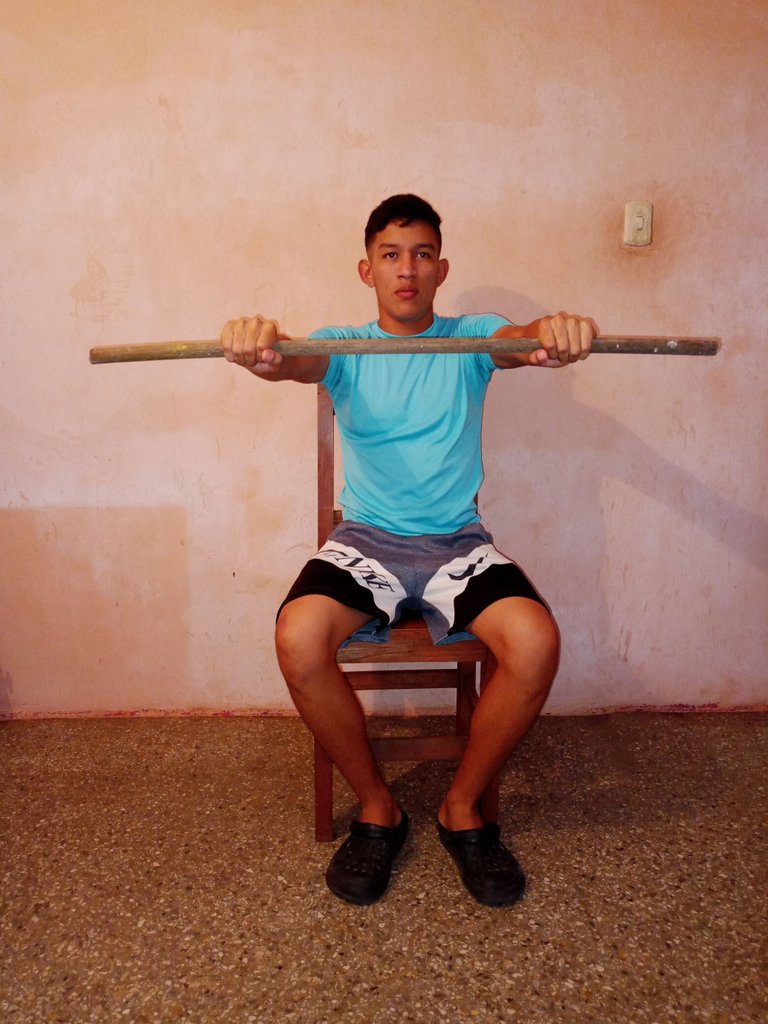
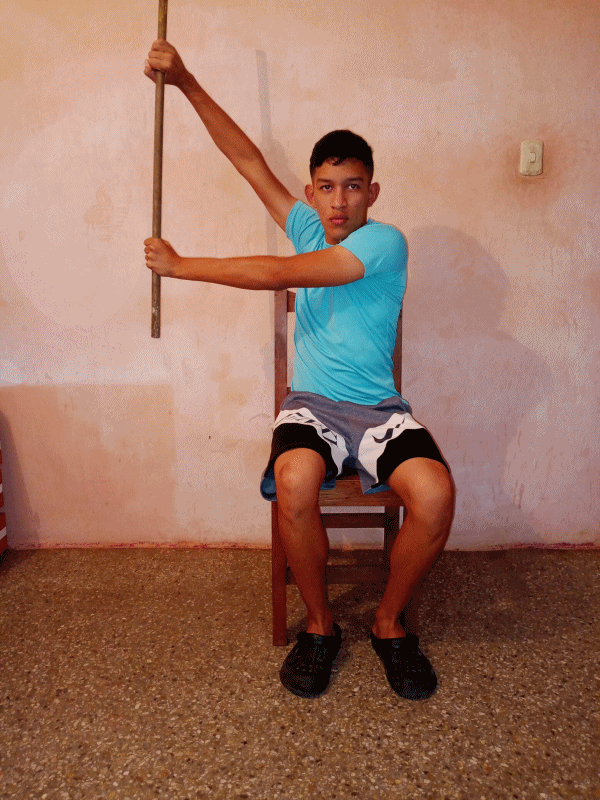
Ejercicio 2: MOVIMIENTOS CON ANTEBRAZOS
Persona sentada en una silla estable con piernas a lo ancho de la cadera, colocamos manos sobre nuestras piernas con palmas hacia abajo, luego volteamos palmas hacia arriba de forma que estas vean hacia el techo. Para este ejercicio no realizaremos una cantidad en específico de repeticiones ya que vamos a variar la velocidad del movimiento, podemos aumentar la dificultad alternando una palma hacia arria y la otra abajo.
Exercise 2: MOVEMENTS WITH FOREARMS
Person seated on a stable chair with legs hip width apart, we place hands on our legs with palms down, then turn palms up so that they face the ceiling. For this exercise we will not perform a specific number of repetitions since we will vary the speed of the movement, we can increase the difficulty by alternating one palm up and the other down.
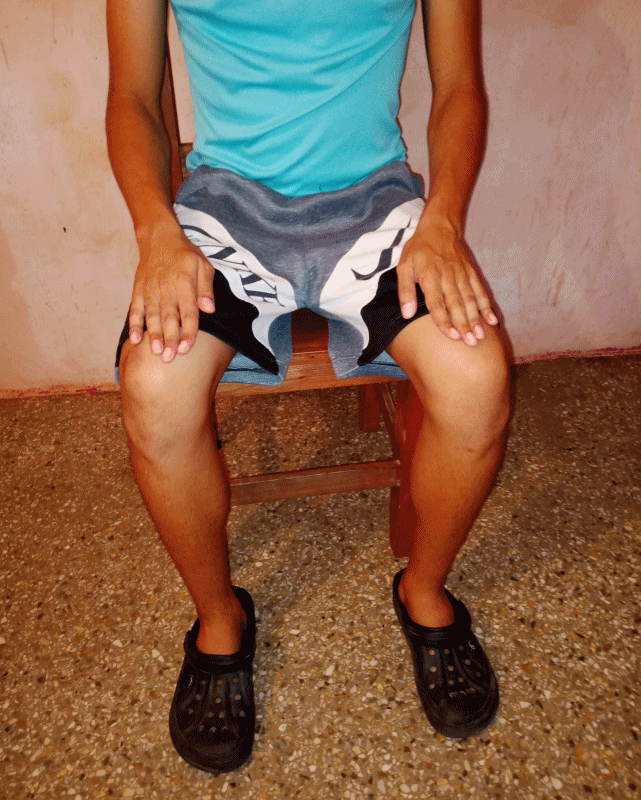
Ejercicio 3: PINZAS
Para este ejercicio comenzamos sentados en una silla estable y colocaremos manos cerca de nuestro rostro y llevaremos cada de hacia el pulgar de forma alterna para crear una pinza, de igual manera al ejercicio anterior vamos a variar la velocidad del movimiento para fomentar la coordinación.
Exercise 3: CLIPS
For this exercise we start sitting on a stable chair and we will place hands near our face and we will take each of them towards the thumb alternately to create a pincer, in the same way as the previous exercise we will vary the speed of the movement to promote coordination.

Ejercicio 4: MOVIMIENTOS PELVICOS
Persona sentada en una silla estable con piernas a lo ancho de nuestra cadera y colocamos manos sobre las rodillas, empujamos una rodilla hacia adelante moviendo la cadera y la pelvis hacia el frente, realizamos lo mismo con el lado contrario y progresamos caminando hacia adelante sobre nuestra silla y de regreso. Realizamos 5 repeticiones hacia adelante y hacia atrás.
Exercise 4: PELVIC MOVEMENTS
Person sitting on a stable chair with legs hip width apart and place hands on knees, push one knee forward moving the hip and pelvis forward, do the same on the opposite side and progress by walking forward on our chair and back. We perform 5 repetitions forward and backward.
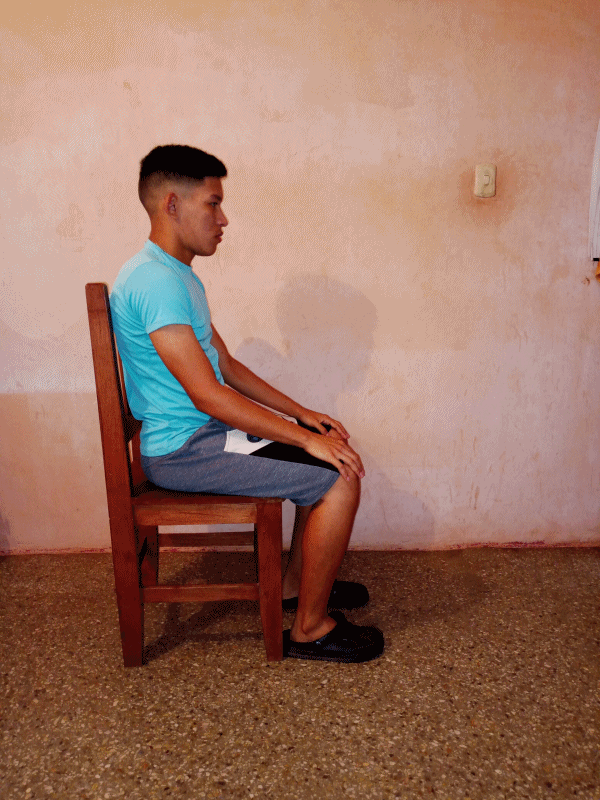
Ejercicio 5: FLEXIBILIDAD DE COLUMNA
Para el último ejercicio nos sentaremos en una silla estable con piernas a lo ancho de la cadera y flexionamos nuestras caderas poco a poco hasta poder abrazar nuestras piernas pegando nuestra barbilla al pecho y mantenemos la posición por 30 segundos, regresamos lento para evitar marearnos y también podemos hacer algo similar y es crear una curva contraria con nuestra espalda llevando las manos al respaldo de la silla y mirando hacia el techo.
Exercise 5: SPINE FLEXIBILITY
the last exercise we will sit on a stable chair with legs hip-width apart and flex our hips little by little until we can hug our legs sticking our chin to our chest and hold the position for 30 seconds, we return slowly to avoid getting dizzy and we can also do something similar and that is to create an opposite curve with our back bringing our hands to the back of the chair and looking at the ceiling.
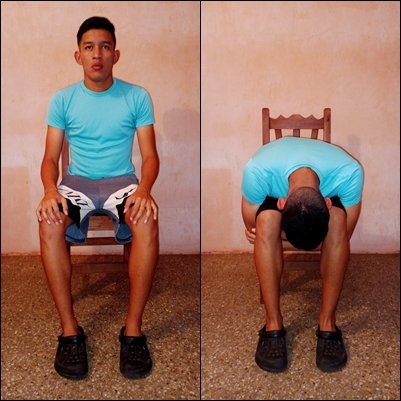
Bueno queridos amigos espero les haya gustado cada uno de estos ejercicios fisioterapéuticos, como pudieron observar es una rutina muy sencilla de hacer, pero sobre todo ayuda mucho con dicha enfermedad y recuerden consultar a su médico antes de poner en practica cada uno de estos ejercicios, hasta una próxima oportunidad cuídense.
Well dear friends I hope you liked each of these physiotherapeutic exercises, as you could see is a very simple routine to do, but above all it helps a lot with this disease and remember to consult your doctor before putting into practice each of these exercises, until next time take care.
Si les gusto déjenme saber en los comentarios como les fue con cada uno de estos ejercicios.
Gracias por leerme
La publicación y fotografías son de mi autoría.
Fotos tomadas por: @alexam99
Teléfono: Infinix hot 10
Traducción: deepl
Collage: fotor
Gif: Photoscape for Windows photoscape
If you like it, let me know in the comments how you did with each of these exercises.
Thanks for readingThe publication and photos are my authorship.
Photos taken by: @alexam99
Phone: Infinix hot 10
Translation: deepl
Collage: fotor
Gif: Photoscape for Windows photoscape
Has sido votado por
PROYECTO ENLACE
'Conectando Ideas y Comunidades'
PROYECTO ENLACE es un proyecto de curación de habla hispana enfocado en recompensar contenido de calidad y apoyar autores en su proceso de crecimiento en HIVE.
Creemos y apostamos por el futuro de esta gran plataforma, y estamos muy emocionados de poder hacerla crecer junto a esta comunidad. Así que te invitamos a usar nuestra etiqueta ENLACE y estar atento a todas las actividades que tenemos preparadas y que estaremos publicando en breve.
¿QUIERES AUTOMATIZAR TUS GANANCIAS DE CURACIÓN? SE PARTE DEL PROYECTO ENLACE APOYANDO A NUESTRO TRAIL EN HIVE.VOTE INGRESA AQUÍ PARA CONCOCER LOS DETALLES.
¿QUIERES INVERTIR ENLACE? DESCUBRE COMO HACERLO Y GENERAR INGRESOS DE FORMA SEMANAL MEDIANTE TU DELEGACIÓN DE HP AQUÍ TE EXPLICAMOS COMO.
Te invitamos a participar en nuestro servidor de Discord: https://discord.gg/3S9y7BbWfS
Atentamente
EQUIPO ENLACE 2021
Excelente publicación, muy didáctica tu presentación y sea tomada en cuenta por personas o familiares con esta condición en mi caso, la voy a pasar por un familiar para fortalecer, además de la visita que hace al neurólogo.
Saludos
Que bueno que le haya gustado y quiera ayudar a familiares o amigos con esa condición, de eso se trata y bueno los mejores deseos para ustedes, cuídense